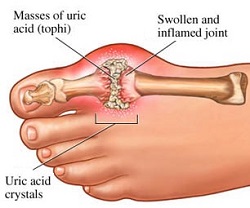Module 7: The ASEAN World of Medicine
Table of Contents
Reading Text & Presentation
7.3.4 Gout

(Source: http://www.gnet.org/gout-no-longer-just-the-affliction-of-kings/ retrieved 3/7/2014)
More common in men than women, gout is characterized by severe attacks of pain in or around a joint. Women can become more susceptible after menopause, and the joint that is most often affected is that at the base of the big toe (podagra). There can also be redness and swelling.
Gout is a complex form of arthritis. An acute attack can wake you in the middle of the night. The pain sensation might be compared to fire or running a fresh cut under cold water, and even the weight of a sheet on the joint can be unbearable. Fortunately, it is treatable, and following strict health regimes can reduce the risk of recurrence.
Gout is caused by increased levels of uric acid in the blood. The acid crystallizes, and the crystals deposit in joints, tendons, and surrounding tissues. Sometimes these crystals can be seen in clinical diagnosis. Acute attacks can be eased with anti-inflammatory drugs, steroids, or colchicine, and once it subsides the levels of uric acid are usually lowered via lifestyle changes. Originally known as ‘rich man's disease’ or ‘the disease of kings’, in the last few decades the disease has become more common due to longer life expectancy and changes in diet.
Consumption of alcohol, fructose-sweetened drinks, meat, and seafood account for most of the dietary causes. Beer and spirits appear to have a greater risk than wine with respect to alcohol, and physical trauma and surgery can also be to blame. Some sufferers have found that the intake of purine-rich vegetables (e.g., beans, peas, lentils, and spinach) has had an effect, but recent studies suggest that these dietary factors are not to blame. Coffee, vitamin C and dairy products, as well as physical fitness, appear to decrease the risk of contracting gout.
